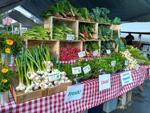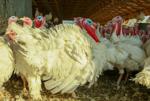Skyler Liebig’s Fresh Take Farm tries to make the world a better place by providing fresh produce for the local community.
He and his fiance, Jessica Duignan, run the business on land that’s been in his family for more than a century, nestled deep in Washington County’s pastoral hill country, 3 miles from the state of Vermont.
There are still a handful of dairy cows on site, primarily for personal milk consumption, but Liebig’s love for agriculture led him down an entirely different career path.
“The whole 24/7 dairy thing didn’t appeal to me much,” he said. “I wanted to find something I really liked and I’ve always liked gardening. My grandparents, (and) aunt and uncle, used to have a huge garden behind the farmhouse here, which is where I started the first plot. I really like growing things more than I like milking cows. That’s where it all began for me.”
Launched in 2015, Fresh Take Farm has survived its critical first five years in business, thanks in part to the COVID-19 pandemic that’s sparked a dramatic increase in demand for fresh, locally produced food during the past year.
Customers have discovered that they can get just about anything they want from this young farm couple, including fresh greens such as spinach, several types of lettuce, kale, arugula and Swiss chard, all grown throughout the year in a non-heated high tunnel and hoop houses. Crops are protected from the cold with double row covers.
“We do quick seedings of radishes along edges of the beds to get a little extra crop in there before the deep freeze hits,” Liebig said. “Early crops in spring are over-wintered onions. Those tend to do really well. We’ve got a certain variety from Johnny’s Selected Seeds in Maine. They’re a much earlier crop of onions. You don’t have to worry about disease pressure. We also have strawberries under row cover now and put small hoops over them to get a little greenhouse effect. We can start picking in late May and early June, a couple weeks before other farms.”
Their outdoor crops, in summer, include carrots, beets, onions, potatoes and sweet potatoes. Their chickens and ducks produce eggs, and the farm also has pigs for pork sales. In addition, Liebig’s father, who currently handles the dairy cows, is considering a switch to beef cattle to further diversify Fresh Take Farm’s income potential.
Moving From Wholesale to Farmers Markets
The farm’s wholesale accounts dried up when the pandemic forced restaurants to close, but a rise in farmers-market business and CSA sales has more than made up for such losses. Fresh Take Farm participates in both winter and summer markets in Glens Falls, New York, about 25 miles away, and recently joined a farmers market at City Hall in much larger Schenectady, New York, another hour south.
“One of the reasons we decided to go that far is that we’re working together with Battenkill (Valley) Creamery,” Liebig said. “We’ve got a good friend there we’re partnering up with. He comes in the morning, puts our produce on his truck and takes it to market.”
Consumer demand drives Liebig’s decisions about what to grow and how much to grow.
“Usually, you sell most of what you bring to farmers markets,” Liebig said. “We try to grow a little bit of everything and focus on faster-growing crops like greens and small root crops like carrots and beets. Greens are really our bread and butter.”
Duignan’s gentle touch is a valuable asset for delicate tasks such as seeding and handling transplants, while she admits that “Skyler is the manual labor guy.”
“We’ve got everything seeded for the season now,” she said. “The greenhouse is for all of our starts and transplants. Now we’ve just got to get them in the ground. Hopefully, the weather is nice and stays nice.”
The same as with just about any farm, Mother Nature is this farm’s biggest challenge. That’s why Liebig prefers growing indoors as much as possible.
Expanding Operations
Construction is currently underway on a new propagation house behind their main barn for year-round microgreen production, transplants and a raised bed on one end for additional in-ground, year-round production.
“The way the weather’s been, covering is always going to be your best bet when growing crops around here,” Liebig said. “It’s much easier to maintain a crop when you can control the water, humidity, air flow and things like that. We’re also putting up two more hoop houses to rotate ground because growing inside them is very intensive. When one crop is done, the next goes in. Or, we do intercropping like raising greens and tomatoes together.”
He is happy to invest in more covered growing areas.
“Growing under cover doesn’t take up much space, but produces more. It’s much more profitable than out in the field,” he said. “You can get more crops per year. Crops grow faster, so the turnaround is quicker. It’s just the controlled environment. There’s less waste of seed and plants and less fertilizer runoff. You’re a little bit more in control.”
This is extremely important given the potentially harmful impacts of climate change, he says.
“I’ve only been on this Earth 28 years, but in that time I can tell that nature is working in different ways than it has in the past,” Liebig said. “The soil here is gravelly, sandy loam, so it drains very well and we get a lot of wind through our valley, so that dries things out very fast. But every year it seems that our water table keeps getting lower and lower.”
Nearby Black Creek, which provides water for the farm’s irrigation, has begun to almost dry up each summer, he said.
“We’re going to have to start getting creative with our water retention methods, reshaping our soil structure by adding more clay for drainage, so there’s less drainage,” Liebig said. “W can get on the field quick in spring, but lately we’re having trouble with summer heat, which keeps getting higher and higher. Last year was extremely hot.”

Construction is underway on a new propagation house for year-round microgreen production, transplants and a raised bed on one end for additional in-ground, year-round production.
“It’s hard to spend all day long out in the sun,” he said. “We’re finding that we have to work different hours now, starting super early in the morning, taking a little break in the middle of the day, and doing a little more in the afternoon and evening when it’s cooler.”
Now in its sixth year of production, Fresh Take Farm is starting a new five-year phase that might very well determine its long-term viability. Liebig and Duignan’s main goal is to make the farm sustainable so their young children, Elliot, 3, and Stella, 1, can have a future there, too, some day.
“It’s not all about money,” Liebig said. “I don’t need to get rich, but I’d like to make a good living. We’d like to increase margins on our production, but also have a good life where we don’t have to work 70 to 80 hours a week. And, (it would be nice to) maybe go on a couple more vacations than before. I enjoy what I do. That’s the reason we do this, (it’s) the passion for growing food for our local community and our family.”
The Link LonkApril 27, 2021 at 05:05PM
https://www.lancasterfarming.com/farm_life/family/a-fresh-take-on-farming/article_1fec048d-ff49-5c34-8ac9-f07553ef2507.html
A Fresh Take on Farming | The Heart of the Farm is the Family | lancasterfarming.com - Lancaster Farming
https://news.google.com/search?q=fresh&hl=en-US&gl=US&ceid=US:en



No comments:
Post a Comment